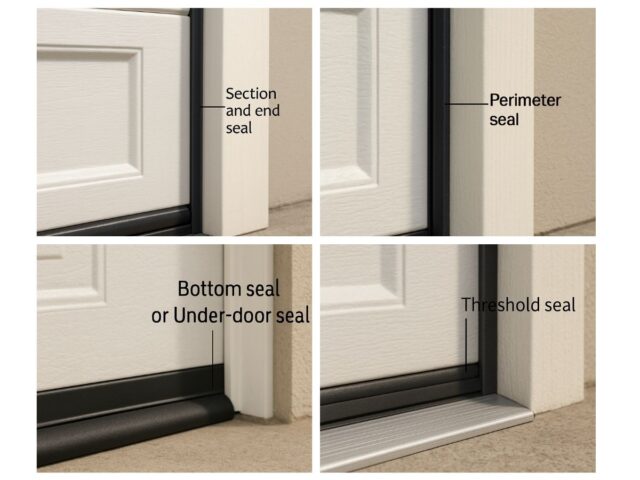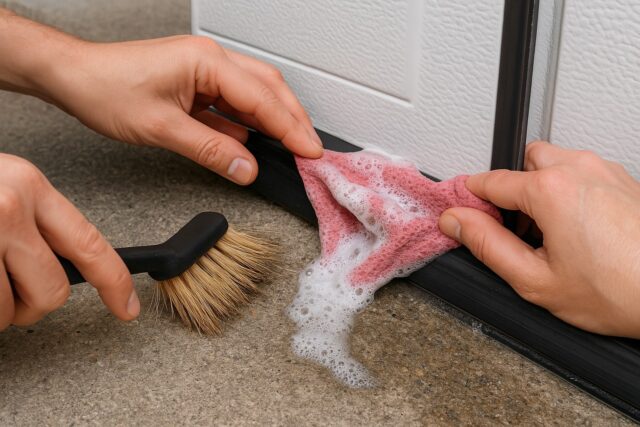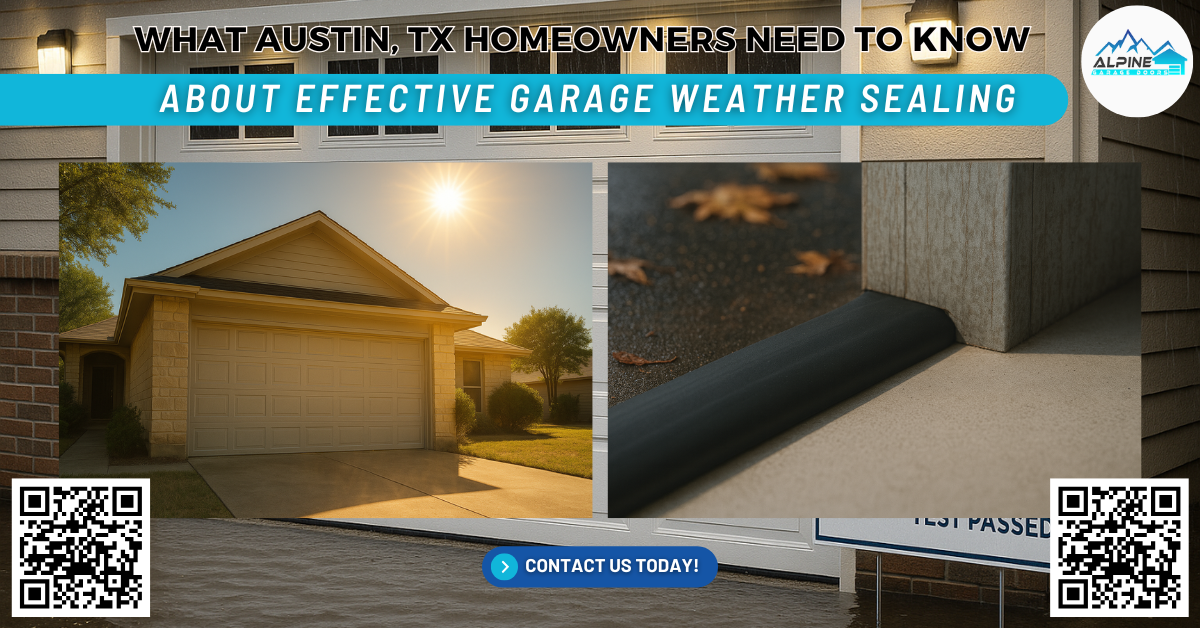Two summers ago, a South Austin homeowner called because her garage felt like a hair dryer. Dust rolled across the floor, warm air leaked in from every edge, and crickets gathered at night. We installed a new garage door seal at the bottom, added a threshold seal on the slab, and tuned the side seal around the frame. After the next storm, the floor stayed dry, and the space felt calm and usable again.
A family in Circle C Ranch faced a different problem. Wind pushed rain under the door and toward a low spot in the center of the concrete. We upgraded the bottom seal to a deeper bulb profile, bonded an aluminum threshold with installation adhesive, and adjusted the opener so the rubber door strip compressed correctly. The next time thunder rolled through Austin, the garage stayed clean.
Stories like these are common in our area. Austin heat hardens old vinyl, sudden downpours test every gap, and dusty wind finds any opening. That is why smart weather sealing matters. In this guide, Alpine Garage Doors Texas explains how to choose parts, how to maintain them, and how to solve tricky water and air leaks in a straightforward way that any homeowner can follow.
Why Weather Sealing Matters in Austin, TX
Austin’s climate is tough on materials and on the edges of a large door. Summer sun dries and cracks low-grade vinyl. Fast-moving storms drive water across the driveway and push it up to the door line. Dust, pollen, and tiny insects slip through small spaces and collect inside. A tight system with a strong garage door bottom seal, a well-set threshold seal, and snug door weather stripping keeps all of that in check.
Good sealing brings clear benefits. Comfort improves because hot air and drafts stay out, which helps if you use the garage as a gym or hobby room. Protection improves because storage boxes, tools, and finishes are less likely to get wet or dusty. Pest pressure drops because insects cannot slip through easy entry points. Energy efficiency improves when the garage shares walls or a ceiling with the living space. Every leak you stop near the garage reduces heat transfer at that common wall.
The Four Lines of Defense in a Sealed Garage Door
A reliable setup works like a layered shield. Each layer blocks a different path for air and water.
Bottom seal or under-door seal
This is the first contact point between the door and the floor. Many doors use a metal retainer that holds a T-style or bulb insert. When the door closes, the insert compresses and fills tiny changes in the slab. EPDM rubber is a strong choice in Austin because it resists the sun and stays flexible. A quality vinyl insert can work for a budget project, but usually needs earlier replacement.
Threshold seal or aluminum threshold
A threshold sits on the slab under the door line and is glued down with installation adhesive. It creates a small rise that helps stop wind-driven rain, and it partners with the bottom seal to block water. Choose a low-profile beveled design so car tires roll across it without a bump. In garages with uneven slabs, the threshold becomes the difference between a damp floor and a dry one.
Perimeter seals for sides and top
Side seal and a top header seal close the gap where the door meets the frame. These pieces are often called door weather stripping, door trim seal, or simply side seal. A flexible rubber or vinyl blade should touch the door face lightly when it is closed. The goal is contact without rubbing. Some installations use Vinyl trim with a built-in blade for a neat finished look.
Section and end seals for special doors
Some commercial or specialty doors use brush seals along the sides and the header, and may add seals between door sections. These are helpful where wind causes panels to flex. Brush seals do not block water as well as a bulb bottom seal, but they do reduce dust and drafts.

Materials and Components That Stand Up to Austin Weather
Picking the right material extends service life and cuts long-term costs. Here is a plain language guide to the parts you will see and what each one does.
EPDM rubber
This tough synthetic rubber handles sun and heat and stays flexible longer than basic vinyl. We prefer EPDM rubber for the garage door seal at the bottom and for rubber door strip sections that take the most sun. If your door faces west in Austin, EPDM is often the best call.
Vinyl sweep and Vinyl trim
A vinyl sweep is common on the service door between the garage and the house. Vinyl trim with a flexible blade works well as a side seal along the jambs. Vinyl costs less up front but can harden faster in strong sun. Plan for seasonal replacement if the door faces direct afternoon light.
Foam weatherstrip tape and Foam tape
Foam weatherstrip tape is helpful for small gaps around frames and for the service door. It compresses easily and fills irregular spaces. It is not a primary water barrier for the main garage door, but it works as a helper material when you need a little more contact in one spot.
Adhesive door seal and Adhesive rubber seal
These seals have a peel-and-stick backing. They are useful where screws are not ideal or where a quick fix is needed. Clean the surface well, let it dry, and press firmly so the adhesive bonds. Use a sealant gun or caulking gun with silicone sealant to seal small edges where needed.
Silicone sealant and Silicone caulk
Silicone sealant stays flexible and resists water, which makes it a good choice for filling small cracks in the slab near the threshold and for window caulking. A bead of Silicone caulk along tiny joints can stop sneaky drips that appear during heavy rain.
Magnetic door strip
This is rare on standard sectional garage doors, but it can help on certain metal service doors inside the garage. A magnetic door strip adds a little closing force that improves draft protection on lightweight doors.
Aluminum threshold
An Aluminum threshold with a replaceable rubber insert is durable and stable on the slab. It is very common for commercial doors and busy residential garages. If the insert wears, you can replace it without removing the aluminum base.
Door sweep and Door sweep kits
For the door that connects the garage to the house, add a door sweep. Many Door sweep kits include a vinyl sweep and mounting screws. This simple part is a major piece of air leak repair and draft protection for living areas.
Window insulation kit and Window insulation film
A clear plastic Window insulation film tightened with a Heat gun or hair dryer adds an extra layer on garage windows in winter. These kits are easy to install and reduce drafts. The film also helps with condensation prevention by keeping warm indoor air off cold glass.
Thermal curtain and heat shrink seal
A thermal curtain on a sunny side window helps keep late-day heat out. A heat shrink seal kit for winter adds a smooth plastic layer that is nearly invisible, and it trims minor air leaks around panes.
Tools that make the job smoother
Bring a Measuring tape to size seals correctly. A Utility knife and a cutting tool handle with bottom inserts. Shears or miter shears give clean corners on perimeter trim. A Caulking gun or sealant gun applies silicone neatly. Keep installation adhesive on hand for thresholds. These simple tools help you produce clean lines and strong bonds.
Selecting the Right Setup for Your Door and Slab
Every garage has its pattern of sun, wind, and water. Matching the setup to those conditions brings the best result.
If the slab is uneven, select a deeper bulb profile for the bottom seal and combine it with a threshold seal that raises the floor line just enough to stop water. For a wood door that swells and shrinks with seasons, choose a softer side seal and leave light contact at the blade so it does not rub. For an insulated steel door, use a high-quality bottom seal and snug side seal to support garage insulation performance. For roll-up doors in workshops, add brush seals at the sides and the header so the door can move in the wind without opening gaps.
Driveways that slope toward the garage need special attention. A threshold and a deeper Garage door bottom seal often solve the problem. During final setup, adjust the opener close limits so the under-door seal compresses correctly at the low point without crushing the insert.
Installation Overview for Homeowners
Many Austin homeowners can handle basic sealing tasks with care and patience. Here is an overview of a typical project so you know what to expect and what to leave to a pro.
Start with inspection. Close the door, turn off the lights, and look for daylight along the sides and at the floor line. Feel for drafts. Check for a cracked seal, a loose door sweep, or seal deterioration. Note where dust or water collects.
Gather tools and parts. You will need a Measuring tape, a Utility knife, Shears or miter shears, a cutting tool for the insert, a Caulking gun or sealant gun, Silicone caulk or silicone sealant, installation adhesive, and the new seals. Have a simple cleaning kit for the slab and the jambs.
Replace the bottom seal. Slide out the old insert, clean the retainer channel, and spray a small amount of silicone-friendly lubricant. Feed the new insert into both channels and pull evenly so it does not twist. Leave a slight wave so it compresses when the door closes. Trim with a Utility knife and cap the ends if your retainer accepts end caps.
Add or upgrade the threshold. Dry fit the threshold and mark its position. Apply installation adhesive in continuous beads. Set the threshold in place and close the door gently so the bottom seal rests on it while the adhesive cures.
Refresh the perimeter. Remove the worn side seal and top seal. Start at the header and set the flexible blade so it just kisses the door face when closed. Work down each side. Use screws so future adjustments are simple and clean. Corner cuts look best when made with miter shears.
Tune and test. Adjust the opener close force and limits so the door compresses the bottom seal without flattening it too much. Check safety sensors and smooth travel. Do a flashlight test at night and a light hose test outside to confirm the water line stays dry.
Know your limits. If the door is out of balance, if a spring or cable looks worn, or if the door rubs hard on the frame, stop and call a professional. Those issues involve safety risks and require training and special tools.
Maintenance, Seal Inspection, and Seasonal Replacement
A little care keeps seals working longer in Austin weather. Plan a seal inspection in spring and again in fall. Sweep the threshold and wipe the bottom seal with mild soap and water so grit does not grind into the rubber. Clean the side seal so the blade stays flexible. Re-check opener close limits after you install new parts. Watch for a cracked seal, gaps at the corners, or a loose door sweep on the service door. In strong sun, expect seasonal replacement of basic vinyl sweeps. EPDM rubber usually provides a longer life in hot conditions.

Troubleshooting Common Problems
Light leaks at the top corners usually mean the header seal or the side seal needs a small nudge toward the door. Loosen the screws by a turn, tap the trim inward, and retighten. A wet stripe in the middle of the floor often points to a shallow dip in the slab. Use a deeper bulb insert or a slightly taller threshold to bridge that dip. If the door rubs the perimeter, the blade is set too tight. Back it off so there is light contact when the door is closed.
Drafts near the door to the house usually respond to Door sweep kits and Foam weatherstrip tape around the frame. If the adhesive does not stick to the slab, clean thoroughly, let it dry, and use installation adhesive designed for the product. For persistent pests, check the ends of the bottom seal and the corners at the threshold. Fill small gaps with an Adhesive rubber seal and confirm the side blades touch the door face without gaps.
Condensation and mold prevention starts with sealing air leaks so humid air does not stream into the garage during storms. Store cardboard on shelves, not on the floor. Use Window insulation kit options in winter and a thermal curtain in summer on sunny side windows. Silicone caulk can close small cracks in the slab near the threshold so water does not wick under the seal.
Comfort, Energy Efficiency, and Helpful Standards
Sealing a garage will not turn it into a living room, but it does support comfort and energy efficiency. The DOE Department of Energy and Energy Star from the EPA both teach that air sealing and insulation reduce wasted energy in a home. ASHRAE provides guidance for ventilation and moisture control, and the International Code Council publishes codes that shape how builders and inspectors think about building envelopes. When you pick electrical or fire-related components, look for listings from Underwriters Laboratories UL. You do not need to study those documents to act. The simple move is to stop the biggest air and water leaks at the door line and the frame. That change helps every nearby room feel more stable in temperature and humidity.
Local Considerations for Austin Homes and Shops
Austin neighborhoods experience different patterns of wind and rain. Homes near Lake Travis often see stronger afternoon gusts. Central streets collect more dust and fine debris. Hill Country lots can place the driveway on a slope that points water at the garage. Cedar pollen season adds extra debris to the door line. Match your materials to those conditions. Choose EPDM rubber inserts for west-facing doors. Add a threshold if the driveway tilts toward the garage. Use snug side seals and a door sweep for the door to the house if traffic dust is common. For workshops with roll-up doors, add brush seals at the sides and a heavy under-door seal.
Frequently Asked Questions (FAQs)
How often should I replace seals in Austin?
Check twice a year. Many homes need a new bottom insert or new side blades every few years. West-facing doors in strong sun usually need earlier service.
Will a threshold make it hard to drive into the garage?
Residential thresholds are low profile and beveled. Tires roll across them smoothly when they are bonded and aligned correctly.
Which material lasts longest in the Texas sun?
EPDM rubber holds up well under UV exposure. It usually outlasts basic vinyl in Austin conditions.
Can I do this work myself?
Yes, if the door is in good shape and you are replacing parts like the bottom insert, the threshold, or the side seals. Use a Measuring tape, a Utility knife, Shears, a Caulking gun, and installation adhesive, and follow the steps above. Call a professional if the door is out of alignment or shows signs of spring or cable issues.
How Can Alpine Garage Doors Texas Help You
If you want a cleaner, drier, and quieter garage without guesswork, our team can help. Alpine Garage Doors Texas installs bottom seals, threshold seals, side seals, and door sweeps that stand up to Austin weather. We use materials that fit your door and your slab, such as EPDM rubber inserts, Vinyl trim options, and Aluminum threshold profiles. We tune opener limits so the new seals compress correctly, and we check rollers, hinges, and sensors while we are on site. You get clear options, fair pricing, and a friendly crew that respects your time.
Call us today at 346 438 1138
Alpine Garage Doors Texas
Address 638 Saddle Rock Dr, Houston, TX 77037
Serving Austin, TX, and nearby communities
Final Thoughts
Weather sealing is a simple upgrade that delivers daily value in Austin. A strong garage door bottom seal, a well-bonded threshold, and properly set side seals keep water, dust, heat, and pests out. Good materials like EPDM rubber and quality Vinyl trim last longer in our sun. Smart add-ons like Window insulation film, Foam weatherstrip tape, and a reliable door sweep make the whole system work better. Start with a quick inspection this week. Note any daylight, drafts, or watermarks. If you want a plan you can trust, schedule a visit with Alpine Garage Doors Texas. We will match the right parts to your home and complete the work with care so your garage stays comfortable and protected through every Austin season.

